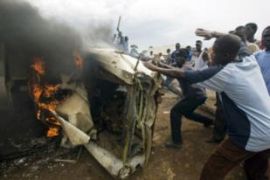In the opposition stronghold of Kisumu, riot police fired teargas on youths who had erected roadblocks on major roads, an AFP correspondent said.
The protesters vowed to avenge the killings of two demonstrators in clashes with police in Kisumu the previous day, the first of three days of mass opposition rallies to protest Kibaki’s re-election in December 27 polls.
In Nairobi on Wednesday, opposition supporters tried to reach the central Uhuru (Freedom) Park – which was ringed by officers in riot gear.
“We are not losing momentum,” William Ruto, a senior Odinga ally, said after his convoy was teargassed as it tried to reach the park.
In Kisumu, security forces shot dead three men.
“The killing by the police is completely unjustified,” Ben Rawlence of Human Rights Watch told Reuters.
“They have not learnt their lesson since killing at least 44 people last week. They must be held accountable.”
In footage shown by local broadcaster KTN, one Kisumu policeman was seen firing his assault rifle at a young man in a black T-shirt who was pulling faces at other officers.
The man in the black T-shirt fell down, then the policeman ran over and kicked him. KTN, which said four people were feared killed in Wednesday’s trouble, said the youth later died.
Across Kenya, more than 600 have been killed in riots and a wave of tribal violence since the outcome of the ballot, which international observers said fell short of democratic standards.
A quarter of a million, many of them members of Kibaki’s Kikuyu ethnic group, have been forced from their homes.
Descent into chaos
Kenya’s descent into crisis has tarnished its democratic credentials, dismayed world powers, scared off tourists and hurt one of Africa’s most promising economies.
The US and former colonial power Britain have called on Kibaki’s government to let peaceful protests go ahead.
They and 11 other nations have threatened to cut aid if the government’s commitment to “good governance, democracy, the rule of law and human rights weakens”.
Since being sworn in on December 30, Kibaki, 76, has entrenched his position by naming most of a new cabinet and calling parliament to meet.
The ODM has 99 seats in the newly elected parliament, making it the largest single party but short of an overall majority.
Kibaki’s Party of National Unity won 43 seats and an ally secured 16.
First defeat
The opposition on Tuesday narrowly got its choice for speaker, Kenneth Marende, elected, dealing the government its first defeat.
Kofi Annan, the former UN secretary-general, was expected to help mediate in the political crisis, but he delayed his trip as he was recovering from a bout of flu.
Speaking from Nairobi, Andrew Simmons, Al Jazeera’s Africa correspondent, said: “The ODM intends to keep up the pressure with demonstrations over the next few days. The government is stressing the term dialogue, not mediation.
“Annan is still sick but he is due here in the next few days. And he needs to address this question: What does dialogue mean?”
